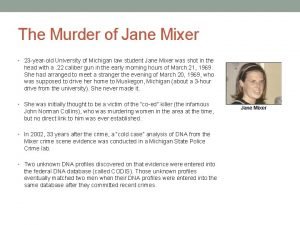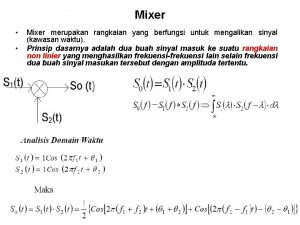The Murder of Jane Mixer 23 yearold University


























- Slides: 26

The Murder of Jane Mixer • 23 -year-old University of Michigan law student Jane Mixer was shot in the head with a. 22 caliber gun in the early morning hours of March 21, 1969. She had arranged to meet a stranger the evening of March 20, 1969, who was supposed to drive her home to Muskegon, Michigan (about a 3 -hour drive from the university). She never made it. • She was initially thought to be a victim of the “co-ed” killer (the infamous John Norman Collins), who was murdering women in the area at the time, but no direct link to him was ever established. • In 2002, 33 years after the crime, a “cold case” analysis of DNA from the Mixer crime scene evidence was conducted in a Michigan State Police Crime lab. • Two unknown DNA profiles discovered on that evidence were entered into the federal DNA database (called CODIS). Those unknown profiles eventually matched two men when their DNA profiles were entered into the same database after they committed recent crimes. Jane Mixer

The two matches • John Ruelas • He murdered his mother in early 2002 • A match to DNA from a blood spot taken from Mixer’s hand in 1969 (and analyzed in 2002) occurred when Ruelas’s DNA was entered into the database in 2003 • Gary Leiterman • Leiterman forged a prescription in 2001 after he had become addicted to pain medication following a bout of kidney stones • A match to DNA from Mixer’s pantyhose collected in 1969 (and analyzed in 2002) occurred when Leiterman’s DNA was entered into the database in 2004

Did they commit the murder together? • Ruelas was only 4 years old in 1969 and was ruled out as a suspect • Why his DNA showed up in the analysis was not explained and remains completely mysterious to this day • Therefore, only Leiterman was convicted of Mixer’s murder • 2005: sentenced to life in prison without possibility of parole • 2007: appeal denied • But what explains the Ruelas DNA evidence?

A Mystery • Somehow, these 3 people became connected to each other • Jane Mixer • John Ruelas • Gary Leiterman • Theory #1 (the prosecution’s theory) • Leiterman killed Jane Mixer and left his DNA at the crime scene in 1969 • 4 -year-old John Ruelas was there, too, and left a drop of blood on Mixer for unknown reasons • The “co-ed” serial killer, John Norman Collins , who was murdering women at the same time and in the same area, was assumed to be innocent of this particular crime • Theory #2 (the defense’s theory) • The DNA samples of all 3 people were analyzed in the same lab at nearly the same time • The Mixer evidence was contaminated with DNA from both Ruelas and Leiterman • The obvious suspect (“co-ed” serial killer, John Norman Collins) committed the murder

DNA Timeline Michigan State Police Lansing DNA Laboratory John Ruelas Evidence from the 2002 Ruelas murder case arrives at the lab and first processed Jane Mixer Ruelas DNA evidence analyzed Jane Mixer cold case evidence from 1969 is pulled out of storage and taken to the lab for processing Ruelas murder evidence further analyzed for DNA between these dates Gary Leiterman’s mouth-swab DNA sample arrives at the lab and is received and stored Mixer evidence analyzed for DNA between these dates 2001 2002 Oct. 24 Oct. 2001 Jan. 29 Feb. 22 Feb. 27 March 26 Feb. 20 -21 Note that these 3 cases are entirely unrelated at this point. No one realizes that a connection between them will eventually be made. Thus, if the prosecution’s theory is correct, then Leiterman and Ruelas were inexplicably together at the murder scene 33 years earlier and then, in an almost inconceivable coincidence, their DNA was being processed at the same lab independently within a day of each other 33 years later. April 5 April 2002 April 19 Cross-contamination is an obvious possibility, but proving it (i. e. , proving innocence) is difficult because the contaminating event would have gone unnoticed and, therefore, would not have been recorded.

Those involved in the DNA analysis maintain that no mistakes were made and that no contamination occurred • Lab technicians and supervisors claim that proper laboratory procedures were followed at all times (e. g. , sterilization procedures, storage protocols, contamination tests, etc. ). Moreover, the evidence from the 3 different cases were analyzed in different physical locations in the lab on different days, thereby rendering cross-contamination (even from unnoticed events) a virtual impossibility • It therefore follows from their interpretation of the results that both Ruelas and Leiterman actually were together on the night that Mixer was murdered (estimated to have occurred between midnight and 3 am), that then-4 -year-old John Ruelas actually did bleed on Mixer at that time, and that the independent arrival of the Ruelas and Leiterman samples in the same lab within a day of each other 33 years later actually was just a remarkable coincidence (Trial. Transcript 7222005. pdf, pp. 54 -56)

An alternative theory is that contamination occurred, but the contaminating event(s) went unnoticed • The DNA analyses for all 3 people were performed in the same lab and at about the same time. The same person handled the Mixer evidence and the Leiterman evidence. • Mixer’s DNA on her own pantyhose was not detectable, but Leiterman’s DNA on the pantyhose was 100 times more plentiful (i. e. , it had not degraded over 33 years of storage, perhaps because it had been recently deposited). • The drop of blood found on Jane Mixer’s hand matched the blood type of both Mixer and Ruelas. Because Mixer had been shot, it could have been her own blood, which was later contaminated with DNA from Ruelas. • Tests showed that Leiterman’s DNA on the pantyhose was not blood or semen but might have been saliva, like his recent mouth swab sample, or some other bodily fluid. • In light of these uncontested facts, it seems irresponsible to reject the possibility (even the likelihood) that cross-contamination occurred – especially when the otherwise incomprehensible DNA match to Ruelas is taken into consideration. • Given the inconclusive nature of the DNA evidence, convicting Leiterman of the premeditated murder of Jane Mixer would only make sense if convincing, independent corroborating evidence of guilt also existed.

The sum total of evidence against Leiterman • The cold-case DNA match, which occurred under disconcerting circumstances • Leiterman, an avid hunter, owned a. 22 caliber pistol in 1969, and Mixer was shot with a. 22. However, one of the serial killer’s other victims was also shot with a. 22 (more on that shortly). • On a phone book found in the student union building where Mixer had arranged a ride home with a stranger, someone had jotted down the words "Mixer" and "Muskegeon. " No one knows if these words were written by the person who killed her. For example, the words could have been written by a reporter calling in the story (Catching Serial Killers, p. 37). The prosecution’s handwriting expert concluded that Leiterman wrote those words, but that same expert mistakenly attributed a handwriting sample from Leiterman's wife to Leiterman himself (Trialtranscript 7212005. pdf, pp. 40 -41). The defense’s handwriting expert conclusively determined that Leiterman did not write those words (Trialtranscript 7212005. pdf, p. 57). Moreover, the entire enterprise of handwriting analysis is scientifically questionable (National Academy of Sciences, 2009).

Who was the serial killer operating in the area at the time? John Norman Collins He was tried and convicted only for the murder of Karen Sue Beineman but is strongly suspected of murdering many of the others on this list Gregory Fournier’s just-published book Terror in Ypsilanti reviews the compelling evidence implicating Collins in most of these murders

Did John Norman Collins also murder Jane Mixer? Mixer was murdered in the middle of this killing spree (March, 1969), but at that time, only she had been shot in the head with a. 22, raising doubts that Collins was the killer

Who was the serial killer operating in the area at the time? But Alice Kalom was also shot in the head with a. 22

Alice Kalom • Kalom was killed 10 weeks after Mixer • The murder weapon was a. 22 caliber gun, just as in the case of Jane Mixer, and “both bullets had six lands and grooves” (Catching Serial Killers, 1991, Earl James, p. 39). • Both Kalom and Mixer were University of Michigan graduate students (unlike the other victims, most of whom were from Eastern Michigan University, where Collins was a student), and her last known location was very close to Mixer’s last known location • Convincing evidence links Collins to the murder of Kalom: • Collins was seen very near Kalom’s last known location on the day she disappeared by someone on the U of M wrestling team who regularly competed against Collins • Roommate Arnie Davis told police that Collins brought Kalom back to their apartment in Ypsilanti that day, and she ran away (with Collins in pursuit) • Collins was known to have recently stolen a. 22 caliber pistol that leaves markings consistent with the bullet that killed Kalom (6 lands and grooves) • Blood found in a car registered to Collins’s mother matched Kalom’s blood on 5 independent factors. The odds of randomly matching an individual drawn from the population on those 5 factors are only 1 in 200 (Catching Serial Killers, p. 66) • Not a shred of evidence links Leiterman to the murder of Alice Kalom (no one has ever suggested otherwise)

Last known locations of the 7 Michigan victims before they disappeared The University of Michigan cluster ? [Side note: this victim, Maralynn Skelton, was known to have been hitchhiking to the EMU student union building and was expected to be there 15 minutes after calling a friend. She may have been abducted near the 4 other EMU victims or by someone en route to EMU. Thus, she is part of the EMU cluster. ] The Eastern Michigan University cluster

Last known locations of the 7 Michigan victims before they disappeared Kalom and Mixer John Norman Collins abducted Alice Kalom from this area. It seems reasonable to hypothesize that he abducted Jane Mixer from this area as well

Here is where the 7 bodies were found Nothing about this pattern implies that Mixer was killed by someone other than John Norman Collins

What was Collins doing on the night of Mixer’s murder (March 20, 1969)? • This is a key question that was never considered, either at Leiterman’s trial in 2005 or at his appeal in 2007. • Notes made by Officer Larry Mathewson (who was involved in the investigation of the serial killings for 14 months in 1969/1970) indicate that Collins did not show up for work the night of March 20, 1969 • Collins normally worked the 11 pm-to-3 am shift • The murder of Jane Mixer was estimated to have occurred between midnight and 3 am of March 21, 1969

David Johnson • On the night she was killed, a note found in Jane Mixer’s apartment indicated that she expected someone named “David Johnson” to show up at 6: 30 pm to give her a ride to Muskegon. When he did not show up on time, she called a different David Johnson who lived on the Michigan campus, but that person knew nothing of these events. In fact, many people named David Johnson in the region were carefully investigated and ruled out as suspects • No connection between the name “David Johnson” and Gary Leiterman was ever established. Serial killer John Norman Collins, on the other hand, was intimately acquainted with someone named David Johnson at Eastern Michigan University (EMU) • Trial testimony of Lieutenant Earl James: Q: “So, there was a David H. Johnson that lived with John Norman Collins when they were both attending EMU. Is that correct? ” A: “That’s true. ” (Trial. Transcript 7142005, p. 115) • Author Gregory Fournier points out that Collins and Johnson had known conflicts and speculates that Collins may have tried to implicate his adversary in this crime

Does the MO in Mixer’s murder exonerate Collins? • Differences between Mixer’s murder and the other 6 murders: • Mixer was not beaten, stabbed or mutilated in an apparent rage, as all other victims were • Mixer was not sexually assaulted, as most other victims were. However, her tights had been pulled down, which implies a sexual motive; a sanitary napkin was still in place, which might explain why an attempted rape and extreme violence were aborted – Collins was repulsed by menstruation (Catching Serial Killers, p. 48) • A ruse ("David Johnson") may have been used on Mixer but was not used on the other victims • Similarities between Mixer’s murder and the other 6 murders: • Mixer was killed in the middle of a serial killer’s murder spree, and her body was found • • in the vicinity of the other bodies Like one other victim, Mixer was shot with a. 22 Like most of the other victims, she was picked up for a ride near a university union building Like several other victims, she had been killed elsewhere and her body dumped, and some of her clothes were neatly stacked around her Like nearly every other victim, a ligature was tied tightly around her neck • Conclusions • Given the differences and similarities, the MO, standing alone, does not conclusively implicate or exonerate Collins • However, the MO does not equally implicate Collins and Leiterman

The worst known behavior of the two suspects • John Norman Collins (by age 22) • Murdered, raped, shot, stabbed and strangled multiple young women • Gary Leiterman (by age 62) • A search of his home following his arrest yielded two Polaroid photos of a 16 -year-old South Korean girl who had lived with the Leitermans as a foreign exchange student. She appeared to be asleep or unconscious, lying on a bed with her dress pulled above her head. Leiterman pleaded guilty to possession of child pornography.

The victims of John Norman Collins The Michigan murders (7 victims) Mary Fleszar Michigan California 1967 Joan Schell Jane Mixer Alice Kalom Maralynn Skelton Karen Sue Dawn Beineman Basom 1968 The California murder (1 victim), committed by Collins during a quick trip to Salinas towards the end of his killing spree. He was indicted in California (but never tried) for this murder, too. 1969 Roxie Ann Phillips

The victims of John Norman Collins Disappeared March 24, 1969 Disappeared March 20, 1969 Jane Mixer Mary Fleszar Michigan California 1967 Joan Schell 1968 Alice Kalom Maralynn Skelton Karen Sue Dawn Beineman Basom 1969 Roxie Ann Phillips

Which theory is more believable? • The defense’s theory that serial killer John Norman Collins murdered Jane Mixer requires one to believe that DNA contamination occurred in the Michigan State Crime Lab in early 2002 (even though the contaminating event was not recorded by lab technicians at the time) – thereby explaining how a 4 -year-old was also improbably implicated in the murder – but does not require one to believe that a remarkable series of unlikely coincidences also occurred • By contrast, the prosecution’s theory that Leiterman murdered Mixer requires one to believe that DNA contamination did not occur, yet all of the following coincidences did occur:

Too many coincidences to believe: • Not only were 4 -year-old Ruelas and 26 -year-old Leiterman implausibly together when Leiterman killed Mixer in 1969, but, incredibly, their DNA was also processed at the same crime lab independently within a day of each other 33 years later – coincidentally around the same time that the Mixer evidence was also analyzed in that same lab • Collins killed his first victim in the summer of 1967 and his second victim in summer of 1968. In late March of 1969, he began an much-accelerated killing spree, murdering at least 5 women over the next 4 months. If Leiterman killed Mixer, this new phase began on March 24, 1969, coincidentally just a few days after Mixer was murdered. • After Leiterman supposedly killed University of Michigan graduate student Jane Mixer with a. 22, Collins coincidentally used a. 22 to kill another University of Michigan graduate student, Alice Kalom • Mixer and Kalom coincidentally disappeared from almost the same spot within weeks of each other • Although Collins had a known tendency to give rides to victims waiting near university union buildings, Leiterman coincidentally picked up Mixer for a ride near the University of Michigan union building (despite having no known association with that university) • Mixer died between 12 am and 3 am on March 21, 1969. While Leiterman was supposedly killing Mixer, Collins coincidentally missed his 11 pm-to-3 am shift that very night • The modus operandi in the Mixer murder, while being utterly dissimilar to any known behavior of her supposed killer, Gary Leiterman, was coincidentally similar in multiple respects to known behavioral propensities of Collins • Collins coincidentally lived with someone named “David Johnson, ” the presumably false name of the person who was scheduled to give Jane Mixer a ride on the night she died

Who killed Jane Mixer? • A jury decided that Leiterman is guilty beyond a reasonable doubt. • However, a strong case can be made that Leiterman is innocent beyond a reasonable doubt and that Collins – the obvious suspect – is much more likely to have killed her.

The victims of John Norman Collins Jane Mixer Mary Fleszar Michigan California 1967 Joan Schell 1968 Alice Kalom Maralynn Skelton Karen Sue Dawn Beineman Basom 1969 Roxie Ann Phillips The simplest theory, by far, is that John Norman Collins killed all 8 of these women. Although only convicted for the last murder, the police believed they had sufficient evidence to convict him for the last 3 murders and possibly for the first 2 as well In addition to these 8 victims, whose lives were cut short by that serial killer, there was one more victim: Gary Leiterman

 Jane mixer 1969
Jane mixer 1969 Jane jacobs columbia university school of general studies
Jane jacobs columbia university school of general studies Identity mixer
Identity mixer Muller mixer diagram
Muller mixer diagram Mechanism of mixing
Mechanism of mixing Mixer sizing calculations
Mixer sizing calculations Rangkaian yang berfungsi untuk
Rangkaian yang berfungsi untuk Pid diagram
Pid diagram Entolator mixer
Entolator mixer Spectrum analysis basics
Spectrum analysis basics Anonymous ethereum mixer
Anonymous ethereum mixer Dual gate mosfet rf amplifier
Dual gate mosfet rf amplifier Plc mixer process control problem
Plc mixer process control problem Dante audio
Dante audio Shampoo formulation ingredients pdf
Shampoo formulation ingredients pdf What is spin plan
What is spin plan Arduino music visualizer
Arduino music visualizer Sripath technologies
Sripath technologies Sis mixer
Sis mixer Eifs mixer
Eifs mixer Microfluidic mixer
Microfluidic mixer Drawbacks of tuned radio receiver are
Drawbacks of tuned radio receiver are Rasberry outline
Rasberry outline Double balanced mixer
Double balanced mixer Definition of mixing
Definition of mixing Helical ribbon mixer
Helical ribbon mixer Self excited mixer
Self excited mixer
















































